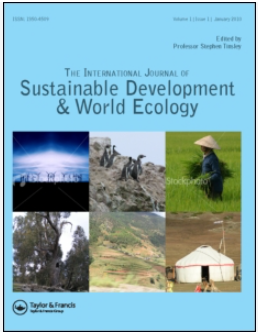Cropping systems intensification and diversification: risk, vulnerability and adaptation in southwest coastal Bangladesh
IF 7.7
3区 环境科学与生态学
Q1 ECOLOGY
International Journal of Sustainable Development and World Ecology
Pub Date : 2022-05-09
DOI:10.1080/13504509.2022.2073615
引用次数: 2
Abstract
ABSTRACT Delta ecosystems are vulnerable to climate change from rising temperatures and altered rainfall patterns, as well as further threats from salinity and erosion due to coastline exposure. Smallholder farmers in deltas are adapting to these risks through cropping systems intensification and diversification, but it is unclear which cropping options offer better profitability and less risk and what transformational support is needed. Using qualitative and quantitative primary field data from southwest coastal Bangladesh, this research analysed risk perceptions and adaptation responses and evaluated the profitability of seven cropping systems. Rainfall anomalies, extreme weather events, and seasonal price fluctuations were core risks for farmers. Risk management strategies included adjusting sowing/transplanting dates, changing crop cultivars, increasing chemical applications, storing irrigation water, and seeking market updates. The dominant systems (rice/rice/fallow, rice/fallow/fallow) had the lowest profitability, while systems with vegetables had the highest profitability. The risk analysis estimated that the dominant systems would incur losses every three years and rice/watermelon/fallow every eight years, but vegetable- or jute-based systems’ risk was negligible. However, expanding vegetable-based systems is constrained by higher input costs, lack of capital, labour-intensive practices, market access, and persistent environmental risks. Therefore, multiple strategies are required by public and commercial actors at multiple levels to support smallholders to promote sustainable trade-offs between diverse risks, short-term profitability, and sustainable managing labour, capital, and inputs. The findings highlight the need for agricultural policies and intervention programs to address production technologies, market access, financial services, and extension and training for production and agribusiness skills. Graphical abstract种植系统集约化和多样化:孟加拉国西南沿海地区的风险、脆弱性和适应性
三角洲生态系统很容易受到气候变化的影响,包括气温上升和降雨模式改变,以及海岸线暴露造成的盐度和侵蚀。三角洲地区的小农正在通过种植系统集约化和多样化来适应这些风险,但目前尚不清楚哪种种植方式能带来更好的盈利能力和更低的风险,以及需要什么样的转型支持。本研究利用来自孟加拉国西南沿海地区的定性和定量原始野外数据,分析了风险认知和适应反应,并评估了七种种植制度的盈利能力。降雨异常、极端天气事件和季节性价格波动是农民面临的核心风险。风险管理策略包括调整播种/移栽日期、改变作物品种、增加化学施用、储存灌溉用水和寻求市场更新。优势系统(水稻/水稻/休耕、水稻/休耕/休耕)的盈利能力最低,而种植蔬菜的系统盈利能力最高。风险分析估计,优势种植系统每3年发生一次损失,水稻/西瓜/休耕系统每8年发生一次损失,但蔬菜或黄麻系统的风险可以忽略不计。然而,扩大以蔬菜为基础的系统受到投入成本较高、缺乏资金、劳动密集型做法、市场准入和持续的环境风险的制约。因此,公共和商业行为体需要在多个层面采取多种战略,支持小农促进在各种风险、短期盈利能力和可持续管理劳动力、资本和投入之间的可持续权衡。研究结果强调,需要制定农业政策和干预方案,以解决生产技术、市场准入、金融服务以及生产和农业综合企业技能的推广和培训问题。图形抽象
本文章由计算机程序翻译,如有差异,请以英文原文为准。
求助全文
约1分钟内获得全文
求助全文
来源期刊
CiteScore
11.10
自引率
3.60%
发文量
58
审稿时长
18-36 weeks
期刊介绍:
The International Journal of Sustainable Development and World Ecology is now over fifteen years old and has proved to be an exciting forum for understanding and advancing our knowledge and implementation of sustainable development.
Sustainable development is now of primary importance as the key to future use and management of finite world resources. It recognises the need for development opportunities while maintaining a balance between these and the environment. As stated by the UN Bruntland Commission in 1987, sustainable development should "meet the needs of the present generation without compromising the ability of future generations to meet their own needs."

 求助内容:
求助内容: 应助结果提醒方式:
应助结果提醒方式:


